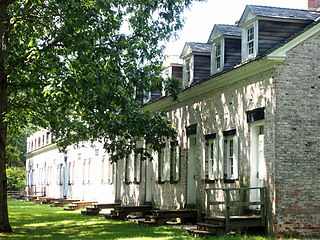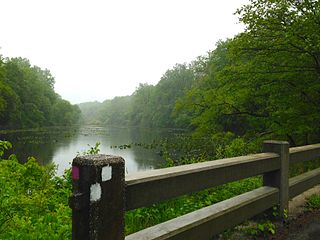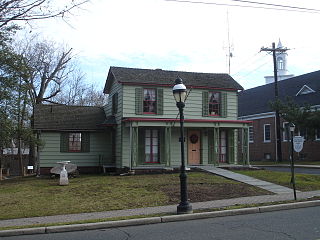
Montclair is a township in Essex County in the U.S. state of New Jersey. Situated on the cliffs of the Watchung Mountains, Montclair is a commercial and cultural hub of North Jersey and a diverse bedroom community of New York City within the New York metropolitan area. The township is the home of Montclair State University, the state's second largest university

Berkeley Heights is a township in Union County, in the U.S. state of New Jersey. Located on a ridge in northern-central New Jersey, Berkeley Heights is a commuter town of New York City in the New York metropolitan area, nestled within the Raritan Valley region and also bordering both Morris and Somerset counties in the Passaic Valley region. As of the 2020 United States census, the township's population was 13,285, an increase of 102 (+0.8%) from the 2010 census count of 13,183, which in turn reflected a decline of 224 (−1.7%) from the 13,407 counted in the 2000 census.

The Great Falls of the Passaic River is a prominent waterfall, 77 feet (23 m) high, on the Passaic River in the city of Paterson in Passaic County, New Jersey. The falls and surrounding area are protected as part of the Paterson Great Falls National Historical Park, administered by the National Park Service. The Congress authorized its establishment in 2009.

The Watchung Mountains are a group of three long low ridges of volcanic origin, between 400 and 500 feet high, lying parallel to each other in northern New Jersey in the United States. The name is derived from the American Native Lenape name for them, Wach Unks. The Watchung Mountains are known for their numerous scenic vistas overlooking the skylines of New York City and Newark, New Jersey, as well as their isolated ecosystems containing rare plants, endangered wildlife, rich minerals, and globally imperiled trap rock glade communities. The ridges traditionally contained the westward spread of urbanization, forming a significant geologic barrier beyond the piedmont west of the Hudson River; the town of Newark, for example, once included lands from the Hudson to the base of the mountains. Later treaties moved the boundary to the top of the mountain, to include the springs.

Garret Mountain Reservation is a 568-acre (230 ha) park located on First Watchung Mountain in Paterson and Woodland Park in southern Passaic County, New Jersey. In 1967, it was designated a National Natural Landmark as part of the Great Falls of Paterson-Garret Mountain listing. The park extends into Clifton. Garret Mountain is Passaic County's major recreational area, providing the visitors with grass fields, several miles of walking/running trails, basketball courts, picnic areas, Barbour's Pond is state stocked with fish for anglers, as well as an Equestrian Center with horseback riding lessons.

Allaire Village is a living history museum located within New Jersey's Allaire State Park in Wall Township, Monmouth County, New Jersey. The property was initially an Indian ceremonial ground prior to 1650, by 1750 a sawmill had been established on the property by Issac Palmer. The village was later established as a bog iron furnace originally known as Williamsburg Forge 'Monmouth Furnace' was then renamed the Howell Works by Benjamin B. Howell. In 1822, it was then purchased by philanthropist James P. Allaire, who endeavoured to turn into a self-contained community. The wood burning furnace business collapsed in 1846 and the village closed. During its height, the town supported about 500 people. Following his death, the property passed through a number of family members before being used by the Boy Scouts who started to restore the buildings for use as a summer camp. Losing the lease, the property then passed to the State of New Jersey. Allaire Village and its existing buildings are now operated by a non-profit organization - Allaire Village, Inc. Historic interpreters work using period tools and equipment in the blacksmith, tinsmith, and carpentry shops, while the old bakery sells cookies, and general store serves as a museum gift-shop styled store. The church building is frequently used for weddings. The site is also host to community events such as community band concerts, antique sales, weekly flea markets and square dance competitions.

Pittstown is an unincorporated community located at the intersection of the boundaries of Alexandria, Franklin and Union townships in Hunterdon County, New Jersey. The area is named after William Pitt. The area is served as United States Postal Service ZIP Code 08867. The area was named Hofftown in the 18th century after landowner Lawrence Hoff. The Pittstown Historic District was listed on the state and national registers of historic places in 1990.

Pottersville is an unincorporated community and census-designated place (CDP) split between Bedminster Township in Somerset County and Tewksbury Township in Hunterdon County, in the U.S. state of New Jersey. The area is served as United States Postal Service ZIP Code 07979. As of the 2010 United States Census, the population for ZIP Code Tabulation Area 07979 was 589. In 1990, most of the village was listed on the National Register of Historic Places as the Pottersville Village Historic District.

Watchung Reservation is the largest nature reserve in Union County, New Jersey, United States. Covering 1,945 acres, it is bounded by the city of Summit, the borough of Mountainside, and the townships of Berkeley Heights, Scotch Plains, and Springfield.

Vincentown is an unincorporated community and census-designated place (CDP) located on the South Branch Rancocas Creek in Southampton Township of Burlington County, New Jersey. The area is served as United States Postal Service ZIP Code 08088.
Cranford, New Jersey is home to a diverse number of historic architectural styles, historically significant buildings, and landmarks. Structures dating from 1740 through the present can be found in a relatively small area of the township.

Goffle Brook Park is a public, county park spanning much of the length of Goffle Brook through the borough of Hawthorne in Passaic County, New Jersey, United States. Since its designation and construction between 1930 and 1932, the park has served to protect the waters of Goffle Brook while at the same time providing recreational opportunities to the residents of Passaic County and nearby Bergen County. Goffle Brook Park has been included in the National Register of Historic Places since 2002.

The Feltville Formation is a mapped bedrock unit primarily in New Jersey, with one known outlier in Pennsylvania and another one in New York. It is named for the Deserted Village of Feltville in Watchung Reservation, New Jersey, which is near where its type section was described by paleontologist Paul E. Olsen.

Lake Surprise is a reservoir made by Surprise Lake Dam on the Blue Brook in Watchung Reservation. On the border of Berkeley Heights and Mountainside in Union County, New Jersey, the lake was created in 1845 for David Felt's papermill.

Rancocas is an unincorporated community located within Westampton Township in Burlington County, New Jersey. The name derives from the Native American word Rankokous, which was used in the name of the Powhatan Lenape Nation Indian Reservation located in Westampton Township. The name was also known as a sub-tribe of the Ancocus. The Reservation was a popular tourist destination for visitors from the Philadelphia area, New York, and local residents, before the Reservation became Rancocas State Park.

The Crane-Phillips House, located at 124 N. Union Avenue in Cranford in Union County, New Jersey, United States, is a Victorian cottage in the architectural style of Andrew Jackson Downing, the first American architect. The Crane-Phillips House is now a museum operated by the Cranford Historical Society that offers visitors a glimpse of what life was like for a modest family in the Victorian era of opulence. It illustrates the late 19th century as the era of invention and highlights inventions that changed everyday life for the average person by way of the house's second owners, the Phillips family. Henry J. Phillips, an American Civil War veteran of the 7th New York Militia, was one of the first inventors of the modern kitchen hood. During the war, he had also patented a convertible tent and overcoat for military use. His brother, Charles Henry Phillips, was the inventor of Phillips' Milk of Magnesia.
Nicaraguan-born Roberto de la Selva (1895–1957) was an artist who moved to Mexico City in 1921 as a protest against U.S. military occupation. He was an associate of Diego Rivera and the brother of poet Salomón de la Selva.

Washington Valley is an unincorporated community in the Whippany River valley within Morris Township in Morris County, in the U.S. state of New Jersey.

The Union County Park Commission Administration Buildings are located in Warinanco Park in Elizabeth, New Jersey. The Administration Building and the Service Building were built in 1924-1925 in the Tudor Revival style soon after the establishment of the commission. They were listed on the state (#2675) and the federal registers of historic places in 1985.

The Crescent Area Historic District is a 47-acre (19 ha) historic district located in the city of Plainfield in Union County, New Jersey. It was added to the National Register of Historic Places on December 12, 1980 for its significance in architecture, featuring Victorian houses built from 1870 to 1900. The district includes 111 contributing buildings.

























